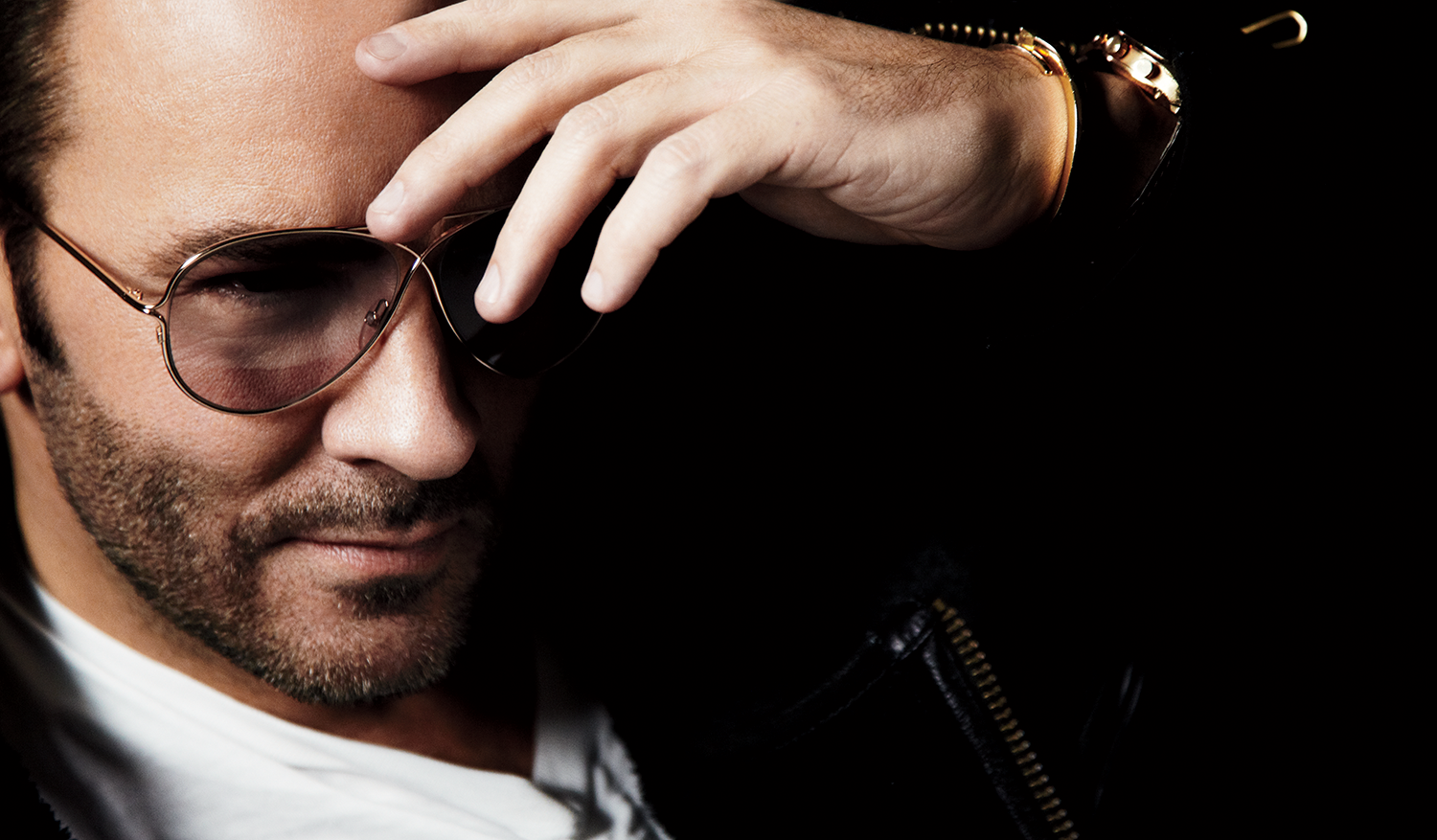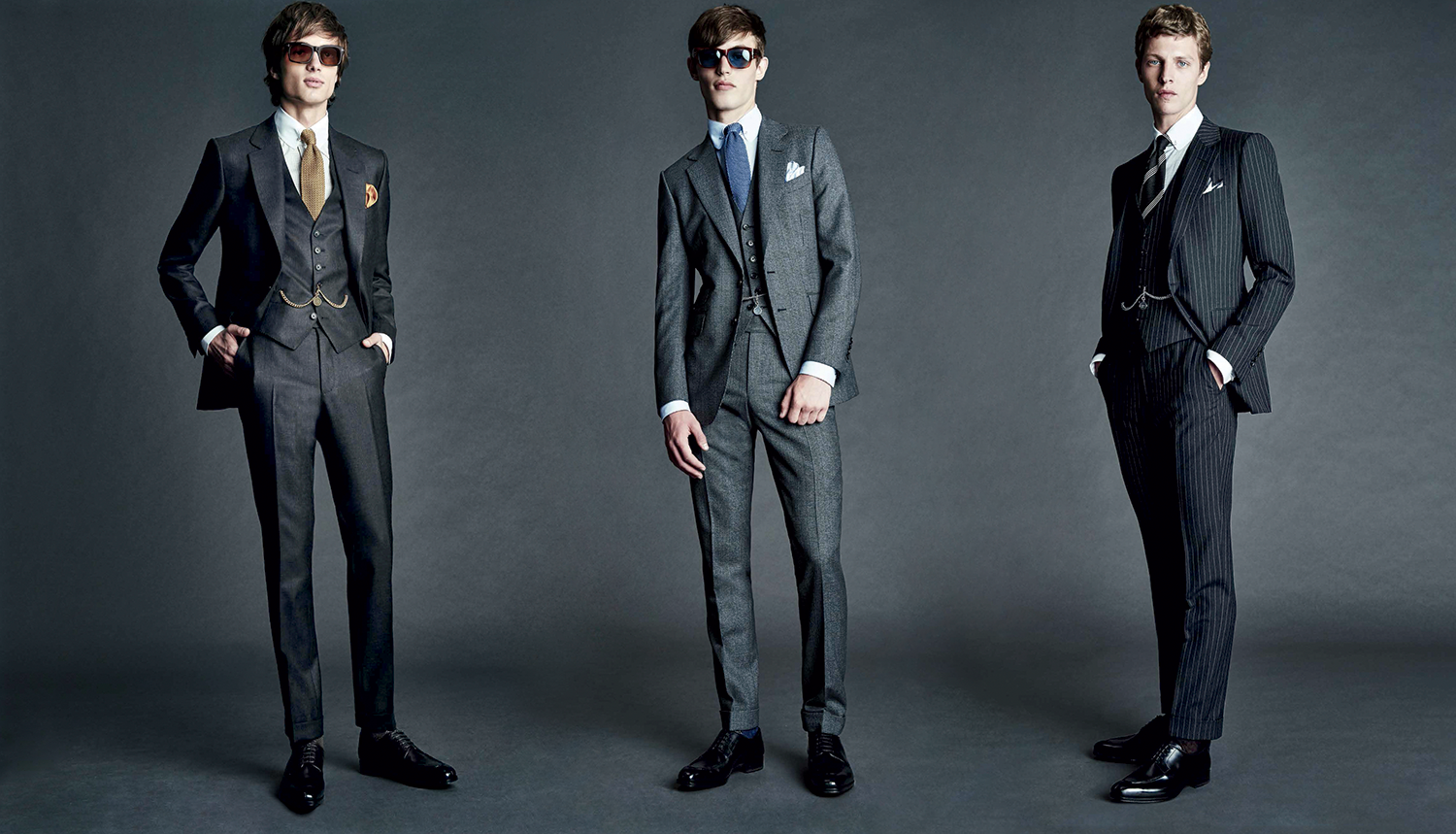The Fantastic Mr. Ford
A personal history of the designer who does it all.

Tom Ford—fashion designer and film director, sex symbol and family man—has made a career of upending expectations. Take his revival of Gucci, one of the great fashion success stories of our era. The Florentine leather goods company, which was founded in 1921 and later expanded into accessories and clothing, had been a favorite of the jet set and Hollywood elite from the 1950s through the 1970s. But the brand was close to insolvency when the Texas-born Ford took over as creative director in 1994.
Coming off the early ’90s recession and the AIDS crisis, anti-fashion was all the rage: Remember the waif, the grunge look, deconstruction, and heroin chic? Ford, then 33, rifled through the company’s archives (“a single cardboard box,” as he later recalled) and through his own memories, conjuring images of sexed-up glamour from a few misbegotten years he spent running around in New York: Warhol and the Factory, Halston and his girls (“the Halstonettes”), living it up in the late ’70s at Studio 54.
At the 1995 MTV Awards, somebody asked Madonna—clad in a shiny teal blouse, unbuttoned to below her bra, and sleek satin hip-huggers— what she was wearing. “Gucci, Gucci, Gucci,” she replied, and a star was born. Soon Ford’s beautifully cut velvet suits with wide lapels, narrow waists, and flared trousers, and his sparkling, barely there column dresses, began showing up on the likes of Jennifer Lopez, Nicole Kidman, and Gwyneth Paltrow. By 1999, the company was worth $4.3 billion, making it among the most profitable luxury brands in the world.
Or consider A Single Man (2009), Ford’s first foray as a film director, after some 15 years spent dressing worldwide lovers of luxury and stars on the red carpet through his work at Gucci and Yves Saint Laurent Rive Gauche. (Ford and his champion and business partner, Domenico De Sole, then head of the Gucci Group, added the storied Parisian fashion house to the Group’s portfolio in 2000.) Based on the eponymous novel by Christopher Isherwood, the film follows a day in the life of a British professor at a Southern California college, a classic outsider who has recently lost his longtime romantic partner in a tragic accident. Heady material, some thought, for a fashion designer to tackle; Hollywood insiders may have rolled their eyes at what appeared to be a vanity project. But Ford made a widely acclaimed film about grief and love, eliciting stunning performances from both his friend and muse, Julianne Moore, and the film’s star, Colin Firth, earning the latter an Oscar nomination.
Through his own label, Tom Ford (cofounded with De Sole in 2005, after both men left the Gucci Group in a dispute over creative control), Ford has clothed everyone from First Lady Michelle Obama (on a visit to Buckingham Palace) to Victoria’s Secret model Candice Swanepoel. The celebrities crowding the front row of his Autumn/Winter 2015 show—held, unconventionally, in Los Angeles just days before the Oscars—included Scarlett Johansson, Amy Adams, Beyoncé, and Jay Z, whose hit single, named after the designer, celebrates the “high” obtained via Ford’s impeccable menswear. Its refrain: “I don’t pop Molly / I rock Tom Ford.”

Even that paragon of urbane masculinity, James Bond, as played by Daniel Craig in his last three films, wears Ford’s sharp-shouldered, nipped-in suits—a black herringbone three-piece when he’s posing as an Italian gangster at a funeral, and a blue Prince of Wales check for leaping across Mexico City rooftops. (Versions of both suits are available in Ford’s Men’s Bond Capsule Collection for 2016.) Combining meticulous Savile Row–style tailoring with the lightness and luxury of Italian manufacturing has won Ford a host of A-list clients, from Bradley Cooper to Karl Lagerfeld, and in 2015, the CFDA award for Menswear Designer of the Year.
Yet fashion’s eternal wunderkind, now 54 and based in London, where he lives with his husband, former magazine editor Richard Buckley, and their toddler son, Alexander “Jack” John Buckley Ford, has said he “like[s] people naked the best.” (The quote is from an interview in Tom Ford, a monograph as sleekly seductive and glossy as the man himself, published by Rizzoli in 2008.) “I suppose that’s why everything I do looks sexy,” he continued, musing, “because if I can take the clothes off, I will.”
Born in 1961 to middle-class parents (both real estate agents) in Austin, Texas, Ford was a metrosexual before the term was invented. He insisted on carrying a briefcase to elementary school, rather than a backpack. His charismatic grandmother, descending in her new Cadillac for visits from Santa Fe, New Mexico (where the family moved when he was 11), helped shape his image of allure. “When bell-bottoms came in, she had them first,” he has said. “She had the biggest, the wildest. Platforms were in? She had the highest. Jewelry—big and flashy. Seen through someone else’s eyes, it was all probably a little bit tacky. Through a child’s eyes, she was just the most glamorous thing ever.”
“I am a perfectionist. This job is a total ego thing in a way. To be a designer and say, ‘this is the way they should dress; this is the way their homes should look; this is the way the world should be.’ But then, that’s the goal: World domination through style.”
Following that dream of style to New York, he enrolled in art history at NYU, switched his major to acting, and dropped out to “be a movie star,” before two years of television commercials and going out every night in New York and L.A. sent him back to school. He graduated from Parsons with a degree in environmental design, but talked his way into a job with fashion designer Cathy Hardwick on Seventh Avenue.
Gucci was another big risk that he pulled off through relentless attention to detail (Anna Wintour has called him “the Flaubert of fashion”), the strength of his vision, and killer commercial instincts, including marketing. He’s ruffled feathers along the way, though. He recalls a letter he received from Yves Saint Laurent, in which the designer wrote to Ford, “In 13 minutes you have destroyed what I have worked for for 40 years.” And an ad Ford orchestrated for the brand’s signature perfume, Opium—shot by Steven Meisel and featuring model Sophie Dahl, naked but for stiletto heels and a diamond necklace, writhing on the floor—was banned in the U.K. But last spring, one of the stars of the Metropolitan Museum of Art’s block- buster fashion exhibition “China: Through the Looking Glass” was a dress by Tom Ford from his last season at Yves Saint Laurent—a sequined, body-hugging, yellow silk satin gown, as mesmerizingly brilliant as an emperor’s robes.
Through it all, with his chiseled features, perfectly groomed stubble, and trim, six-foot-tall figure, plus his evident charm, unstoppable drive, and appetite for fun, Ford has been the best advertisement for the brands he has led to triumph. (His “mass luxury” company, Tom Ford International, currently does over $920 million of business per year; Ford’s personal wealth is estimated at more than $184 million.) “You have to be somebody people are interested in knowing,” he explains of the designer’s role today. “How does this person live? What does he eat? What does he drink?… The fact is that I am a personification of the brand. I am some- thing that can speak and walk the talk.”
In his case, it means an impossibly sleek, midcentury modern, Richard Neutra–designed house in Los Angeles (an art director’s dream); a Santa Fe ranch, at once minimalist and spectacularly abstract, designed by Japanese master architect Tadao Ando; and a London townhouse now uncharacteristically “covered in plastic toys” thanks to son Jack, as he recently confided to London’s Evening Standard. It means keeping himself an “exact size 48 perfect regular,” in order to fit into samples of his own menswear line and to look sharp on the arm of Julianne Moore (at this year’s Golden Globes) or model Joan Smalls (at the Met’s 2013 Costume Institute Gala). And it means maintaining a certain level of ambition.
Ford’s second feature, Nocturnal Animals, a thriller starring Amy Adams and Jake Gyllenhaal, is currently in postproduction. The subject of a furious bidding war at the Cannes Film Festival, it will be released by Focus Features later this year. “I am a perfectionist,” Ford said in 1996, just as he was stepping into the limelight. “This job is a total ego thing in a way. To be a designer and say, ‘This is the way they should dress; this is the way their homes should look; this is the way the world should be.’ But then, that’s the goal: world domination through style.” We couldn’t agree more.
